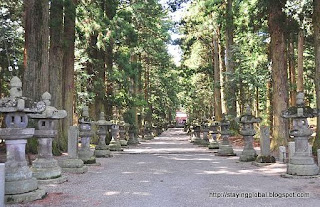On
our way from Lake Yamanaka to Lake Kawaguchi, we stopped by the Fujiyoshida
Sengen shrine.
The
Fujiyoshida Sengen shrine is dedicated to Konohanasakuyahime, the Shinto deity
associated with Mt Fuji. The formal name of the shrine is Kitaguchi Hongu
Sengen Jinja which means North Entrance Sengen Main Shrine and the name derives
from the fact that this is the Main Sengen shrine on the north side of the
shrine. There are more than 1000 Sengen shrines dedicated to Mt Fuji across
Japan, but the main deity of Mt Fuji is believed to be enshrined in the
Fujiyoshida Sengen shrine.
The shrine served as the focal point of Mt Fuji worship during the Edo period.
Traditionally, climbers would begin their Mt Fuji ascent after praying at the Fujiyoshida Sengen Shrine. The old trail begins from behind the Shrine’s main hall. A wooden trail behind the shrine marks the beginning of the traditional trail.
The shrine served as the focal point of Mt Fuji worship during the Edo period.
Traditionally, climbers would begin their Mt Fuji ascent after praying at the Fujiyoshida Sengen Shrine. The old trail begins from behind the Shrine’s main hall. A wooden trail behind the shrine marks the beginning of the traditional trail.
Even
to this day, few climbers, mostly those undertaking the climb as a pilgrimage
begin their climb after offering prayers at the shrine. However, most climbers
prefer to begin their ascent from one of the several 5th stations of
Mt Fuji, Kawaguchiko 5th station being the most popular starting
point. It is said that if the climb is begun from the Fujiyoshida Sengen
shrine, it takes about 8-10 hours to reach the summit.
The
shrine is surrounded by a dense pine and cedar forest.
The path leading to the shrine is lined by stone lanterns on either side.
The path leading to the shrine is lined by stone lanterns on either side.
The
large wooden torii gate of the Sengen shrine is over 18 m high and is counted
amongst one of the largest wooden gates in Japan.
According to tradition, the torii is rebuilt slightly larger, every six decades. Near the top of the Torii, a signboard reads "Sangoko Daiichizan", which translates to the highest mountain among three countries- Japan, India and China.
According to tradition, the torii is rebuilt slightly larger, every six decades. Near the top of the Torii, a signboard reads "Sangoko Daiichizan", which translates to the highest mountain among three countries- Japan, India and China.
The
shrine buildings are painted in red, as in most other Shinto shrines.









No comments:
Post a Comment